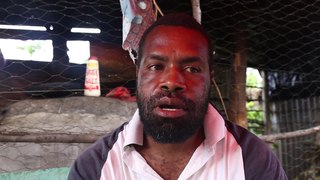Bilabial trill may refer to:
Bilabial trill may refer to:

Blowing a raspberry, strawberry, or making a Bronx cheer, is to make a noise similar to flatulence that may signify derision, real or feigned. It may also be used in childhood phonemic play, either solely by the child, or by adults towards a child to encourage imitation to the delight of both parties. It is made by placing the tongue between the lips, or alternately placing the lips against any area of skin, and blowing. When performed against the skin of another person, it is often a form of tickling. In the terminology of phonetics, the former sound has been described as a voiceless linguolabial trill,, and as a buccal interdental trill,.

The voiced bilabial trill is a type of consonantal sound, used in some spoken languages. The symbol in the International Phonetic Alphabet that represents the sound is ⟨ʙ⟩, and the equivalent X-SAMPA symbol is B\.
In phonetics, a trill is a consonantal sound produced by vibrations between the active articulator and passive articulator. Standard Spanish ⟨rr⟩ as in perro, for example, is an alveolar trill.
The Manus languages are a subgroup of about two dozen Oceanic languages located on Manus Island and nearby offshore islands in Manus Province of Papua New Guinea. The exact number of languages is difficult to determine because they form a dialect continuum. The name 'Manus' originally designated an ethnic group whose members spoke closely related languages and whose coastal dwellers tended to build their houses on stilts out over the sea.
Doubly articulated consonants are consonants with two simultaneous primary places of articulation of the same manner. They are a subset of co-articulated consonants. They are to be distinguished from co-articulated consonants with secondary articulation; that is, a second articulation not of the same manner. An example of a doubly articulated consonant is the voiceless labial-velar plosive, which is a and a pronounced simultaneously. On the other hand, the voiceless labialized velar plosive has only a single stop articulation, velar, with a simultaneous approximant-like rounding of the lips. In some dialects of Arabic, the voiceless velar fricative has a simultaneous uvular trill, but this is not considered double articulation either.
Toda is a Dravidian language noted for its many fricatives and trills. It is spoken by the Toda people, a population of about one thousand who live in the Nilgiri Hills of southern India. The Toda language originated from Toda-Kota subgroup of South Dravidian.
The voiceless bilabially post-trilled dental stop is a very rare consonantal sound used in no more than five spoken languages, of which four are in South America and one, Sangtam, is in Northeast India. The symbol in the International Phonetic Alphabet that represents this sound is ⟨t̪ʙ̥⟩, and the equivalent X-SAMPA symbol is t_dB\_0.
Ajië is an Oceanic language spoken in New Caledonia. It has approximately 4,000 speakers.
ʙ is an extended Latin letter used as the lowercase B in a number of alphabets during romanization. It is also used in the International Phonetic Alphabet to denote a voiced bilabial trill. In the Uralic Phonetic Alphabet, it denotes a semi-voiced bilabial stop consonant.

The Namakura language, Makura or Namakir, is an Oceanic language of Vanuatu. The language is spoken in Shefa Province, north Efate, Tongoa, and Tongariki.
Mangbetu, or Nemangbetu, is one of the most populous of the Central Sudanic languages. It is spoken by the Mangbetu people of northeastern Congo. It, or its speakers, are also known as Amangbetu, Kingbetu, Mambetto. The most populous dialect, and the one most widely understood, is called Medje. Others are Aberu (Nabulu), Makere, Malele, Popoi (Mapopoi). The most divergent is Lombi; Ethnologue treats it as a distinct language. About half of the population speaks Bangala, a trade language similar to Lingala, and in southern areas some speak Swahili.
Sangtam, also called Thukumi, Isachanure, or Lophomi, is a Naga language spoken in northeast India. It is spoken in Kiphire District and in the Longkhim-Chare circle in Tuensang district, Nagaland, India.
Kilmeri, or bo apulyo is a Papuan language of Papua New Guinea near the border with Indonesian Papua. It is not being learned by children.
Ninde, or Labo is an Oceanic language spoken by about 1,100 people in the Southwest Bay area of Malekula island, in Vanuatu.
Avava (Navava), also known as Katbol, Tembimbe-Katbol, or Bangsa’ is an Oceanic language of central Malekula, Vanuatu. It has nasalized fricatives and a bilabial trill.
Ahamb, also spelled Axamb or Akhamb is an Oceanic language spoken in South Malakula, Vanuatu. Ahamb has around 1000 speakers, most of whom reside on the small low-lying Ahamb Island and the nearby Malekula mainland. The language is endangered due to a number of factors, including climate change and environmental factors.
The voiceless bilabial trill is a type of consonantal sound, used in some spoken languages. The symbol in the International Phonetic Alphabet that represents this sound is ⟨ʙ̥⟩.
The following is the chart of the International Phonetic Alphabet, a standardized system of phonetic symbols devised and maintained by the International Phonetic Association. This article is not a complete list of all possible speech sounds in the world's languages, but is used as a page for internal navigation within Wikipedia.